France – Burgundy (Dijon) September 14-15, 2019
Flavigny sur Ozerain. A NM “small town”, it is 6kms north of the highway. It is a wonderful pedestrianized medieval town with narrow lanes that are a joy to walk.
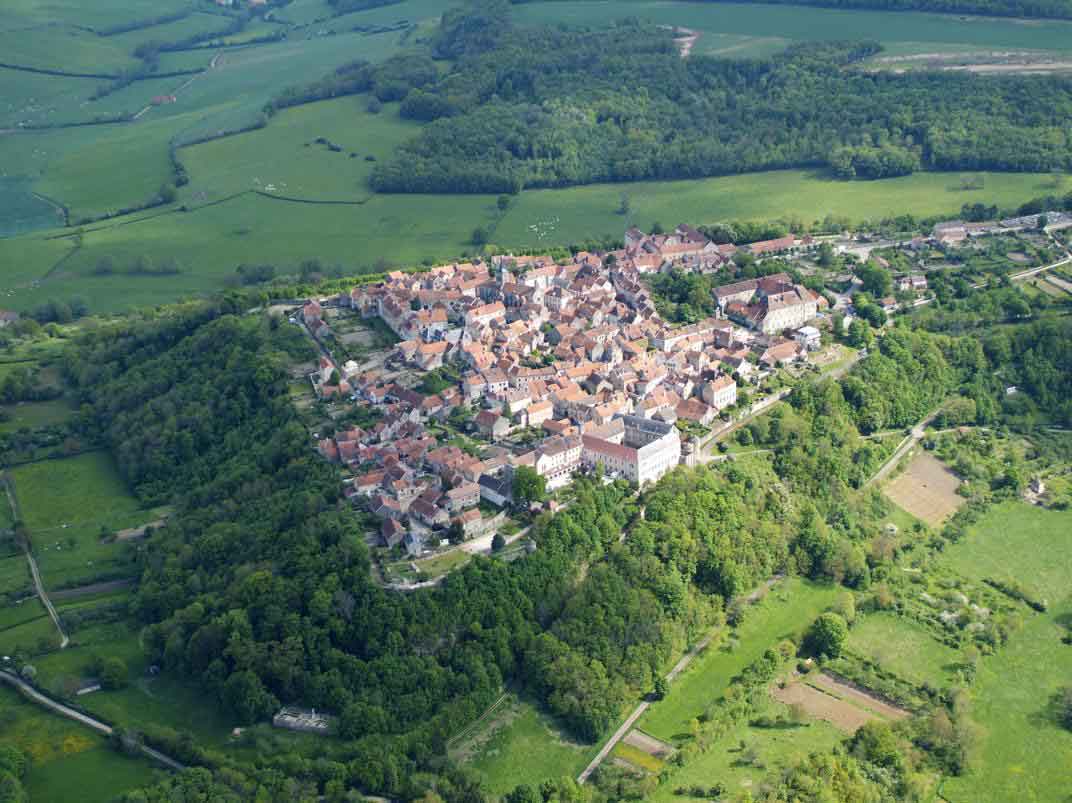
CLIMATS, TERROIRS of BURGUNDY
A World Heritage Site, these are a series of properties that exemplify the viticulture practices of the Burgundy wine region, including climate, a political regulatory impetus, and terroirs, an agricultural system sympathetic to local geography, geology and climate. It includes: Vineyards and production units of the town of Beaune and nearby villages and the historic center of Dijon.
A terroir (character) is the set of all environmental factors that affect a crop’s phenotype, farming practices and crop’s specific growth habitat. It is the basis of French wine appellation and regulation in France and around the world. The system presumes that the land from which the grapes are grown imparts a unique quality that is specific to growing the grapes (the plant’s habitat). This includes the climate, soil type, geomorphology and organisms growing in, on and round the vine plots. This interaction is generally broken down from the macroclimate of a larger area (ex. Cote de Nuits region of Burgundy), down to the mesoclimate of a smaller subsection of the region (ex. the village of Vosne-Romanee) and even to the individual microclimate of a particular vineyard or row of grapevines (ex the Grand Cru vineyard of La Grande rue). The soil relates to the fertility, drainage and ability to retain heat. Geomorphology refers to the mountains, valleys, bodies of water, including the aspect of elevation of the vineyard location.
The definition of terroir can be expanded to include the human controlled aspect – the grape variety planted, using wild or ambient yeast in the fermentation instead of cultured yeast, the use of oak (controversial) or whether organic over a conventional method of farming is used.
DIJON
Musée Magnin. This is the collection of Maurice nagnin (1861-1939), referendum councilor in Accounts Court and art lifer and his ister Jeanne ((1855-1937, painter and amateur art clinic, randomly put together at auctions. It is mostly French from the 16th and 19th century (art I hate). There is also furniture and rooms.
Palace of the Dukes and Estates of Burgundy. Fronting the large main semi-circular town square, it originally was a simple residence until the Hôtel des Ducs was rebuilt in the 14th to 15th centuries, added to in the 18th century and renovated many times in the next 100 years. A major aim of the Dukes was to promote winemaking excellence starting with orders dating from 1395 and 1441 to prohibit growing gamsy grapes in favour of pinot noir. It now holds the Dijon Municipal Archives in one wing and documents relating to winemaking activity. The other wing is a Fine Arts Museum (free) and the facility holds many weddings. Free
Musée des Beaux-Arts de Dijon. In the Palace of the Ducs de Burgundy, it has a wide selection of art and decorative arts. The highlight is the two tombs with wonderful bas relief carvings.
Museum of Sacred Art. In an old round church with a huge central dome, this has a lot of chalices, other religious paraphernalia and several altars. Zero English. Free
Musée de la Vie Bourguignonne. Basically the local museum, it has art, traditional dress, pottery and glass and several rooms decorated to the times, ie an ethnography museum. Free
Botanical Gardens of Dijon (Jardin de l’Arquebuse). Located in a large park and garden created on the former 16th century training grounds of the chevaliers (musketeers) of the arquebus, this is a wonderful ornamental garden with an emphasis on flora of Bourgogne with 4000 varieties of plants including succulents. Mediterranean plants, a herbarium greenhouses and many ducks, geese and swans. The park also has a natural history museum and arboretum. Free
Monument à Vercingétorxi, Alise-Sainte-Reine. This is a statuary monument dedicated to the Gaulish chieftain Vercingetorix, defeated by Julius Caesar in the Gallic Wars.
In 1865, a statue of Vercngetorix was erected to mark the end of the archaeological excavations and their success in identifying Alesia as Alise-Sainte-Reine. The face of the chief of the Arverni was modeled on that of Napoleon III himself. Vercingetorix is depicted looking towards the field of battle in a pose of resignation and defeat.
Sitting on top of the hill above the town, a large bronze statue sits on top of round stone base with a copper band with an inscription.
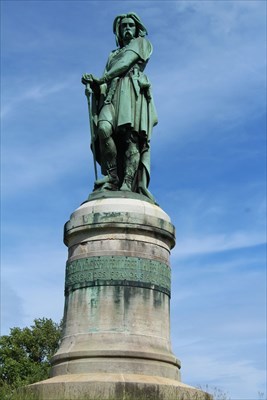
CISTERCIAN ABBEY of FONTENAY
It was founded by Saint Bernard in 1118 making it one of the oldest Cistercian abbeys originating from the Cistercian order founded in 1098 in Citeaux. Before building the abbey, they cleared and drained the swamps (Fontenay’s Latin name, Fontanetum, meads “which swims onto springs”. The Cistercian order prescribed to a life of poverty, based on self-sufficiency and solitude. The abbey was very wealthy from the 12th to the 16th century with a more than 200 monks. The large estate had cattle, vineyards and an innovative forge. In the 16th century, it went into decline. At the time of the French Revolution, only 12 monks remained and it became state property in 1790 and in 1820 was sold to Elie de Montgolfier (a descendent of the hot air balloon inventors) and transformed into a paper mill. After 1906, the owner did a massive restoration removing all the paper mill buildings and it is still owned by the Aynard family.

Church. Started in 1139 and consecrated in 1147, the façade is stripped bare and the original vestibule was destroyed in the 18th century. It is a large, 3-nave Latin cross made of small limestone blocks, 8 columns per side, 66m long and 16.7m high. Its style is pure Romanesque with pointed barrel vaults. The capitals are very plain so that nothing would distract the eye or the mind from prayer. The statue of Our Lady of Fontenay in the north wing of the transept is late 13th century and one of the finest statues in Burgundy. The 13th century floor of the sanctuary is paved with enameled tiles. One of the tomb stones is of Bishop Ebrard of Norwich who oversaw the construction after having fled persecution in England. The remains of the Knight Mello d’Epoisses and his wife (a noble family of Burgundy) lie near the front. It has lovely geometric stained glass. 
The dormitory has a magnificent oaken framework. The monks slept on simple pallets laid directly on the floor.
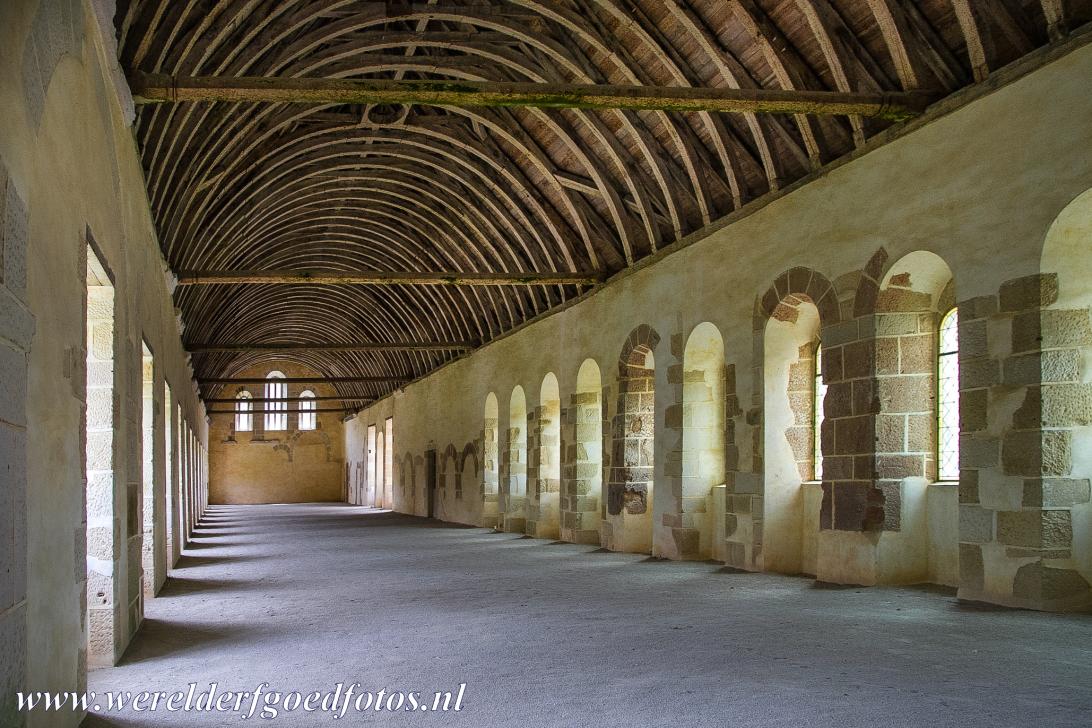
A cloister (with its aisles is 36x38m) sits in the middle of the monastery.

In the chapter house with its crossed rib vaults, the monks daily read a chapter of the Rule of St Benedict. There are several buildings that can’t be entered and are actively used by the present owners.
The highlight may be the 52m-long forge from the end of the 12th century. Using iron ore mined on a hill overlooking the monastery, a still functional water wheel ran a hydraulic hammer producing tools and bars sold locally.
Wall, trimmed lawns, fountains, small canals and the functional water wheel make it a very attractive place. €10
VÉZELAY
Vézelay, Church and Hill. A World Heritage Site (1979): From the 9th to the 16th centuries, Vézelay was a Benedictine abbey. The monastic buildings covered most of the summit of the hill. Beginning at the end of the 13th century, there was a gradual decline and decay. By the French Revolution, many of the buildings were in ruins. Today the brethren and sisters of the Jerusalem Fraternities continue the monastic witness. Buildings that have disappeared: former abbot’s residence, abbatial residence actually under construction at the time of the French Revolution, chapel, kitchens, salt store (1712), lodgings and out-buildings, ice house, mortuary chapels.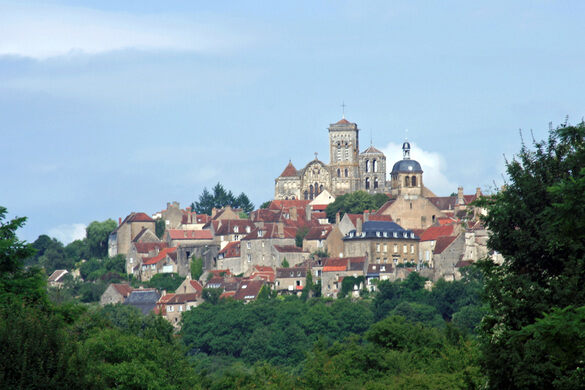
Buildings that remain: ground floor chapter house, supper floor dormitory, refectory, the abbey (today the basilica), cloister, abbot’s lodgings until 18th, from the 19th, the deanery, cellar, parlors, porter’s lodge.
Chapel. The chapel is lovely with cross-ribbed vaults each with 5 rosettes and 8 columns per pillar.
Crypt. Rough stone floor, 8 columns, relics of St Marie-Madelaine, ceiling bricks of two vaults painted.
Church. 3-naved, with large simple semi-circular side chapels, each devoted to a saint and only its statue present, small crossing. Ceiling simple transverse arches of tan and white. The highlight for me was the intricate carved capitals on the 10 multi-lobed columns per side. I followed a woman from Paris who had a guide book with the details of the stories behind each capital. Free 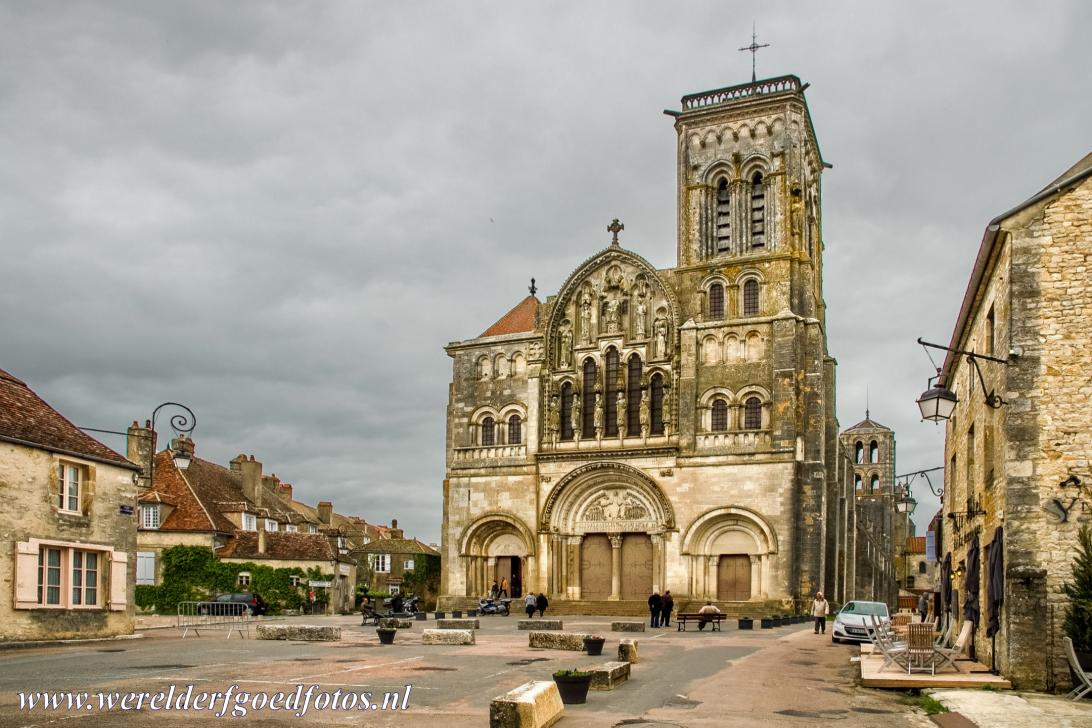
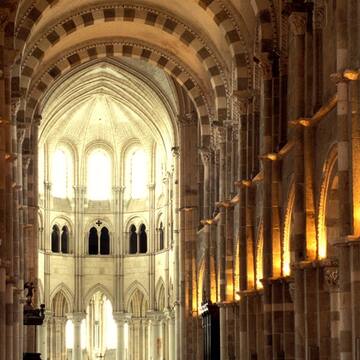
Park at the bottom of the hill as the road is pedestrianized and for local traffic only. The street is lined with restaurants and art galleries. The front of the church is covered is covered in scaffolding with a fake picture of the magnificent portal. The chancel and apse part of the church (both outside and inside) have been cleaned and present an almost new, very light appearance. Most of the carvings on the columns have also been cleaned.
Cathedral Saint-Lazare, Autun. A Romanesque church was built here in the 12th century to house the relics of Saint Lazarus, Jesus’ host and friend. His tomb is built like a small church and stands in the middle of the chancel. The spire, side chapels and organ loft were built in the 15th and 16th centuries.
A large 3-nave Gothic church, all grey stone intricate columns and gothic arches. The highlights are the carved capitals on the columns (the good leaflet available gives good understand the meaning of the bible stories depicted) and tracery at the back of the church outlining the arches. The tympanum over the front portal is also described in the leaflet. Most of the side chapels were being renovated. I was all alone at 08:40 on a Sunday morning. Free
Paray-le-Monial Basilica, Paray-le-Monial. This has a very large crossing making it almost square and chairs surround the altar. The white walls and cream stone columns and arches make it very attractive. A large mural is in the dome of the apse. The many small stained glass windows are all set deeply into the thick walls. Free
GO TO France – Rhône-Alpes (Lyon, St. Étienne, Grenoble, Valence)
NOMAD MANIA France – Burgundy (Dijon)
World Heritage Sites
Cistercian Abbey of Fontenay
Climats, terroirs of Burgundy
Routes of Santiago de Compostela in France
Vézelay, Church and Hill.
Tentative WHS
Sites funéraires et mémoriels de la Première Guerre mondiale (Front Ouest) (07/04/2014)
Borders: France-Switzerland
XL: Hotel Arbez Franco-Suisse
Museums
Beaune: Musee des Beaux-Arts
Chalon-sur-Saône: Musée Nicéphore-Niépce
Religious Temples
Autun: Cathedral Saint-Lazare
Auxerre: Auxerre Cathedral
Marmagne: Abbey of Fontenay
Paray-le-Monial: Paray-le-Monial Basilica
Saint-Nicolas-lès-Cîteaux: Cîteaux Abbey
Sens: Sens Cathedral
Monuments: Alise-Sainte-Reine: Monument à Vercingétorix
House Museums/Plantations: Arbois: Maison Louis Pasteur
European Cities
DIJON
Railway, Metro, Funiculars, Cable Cars: Dijon tramway
Museums
Musée de la Vie Bourguignonne
Musée des Beaux-Arts de Dijon
Museum of Sacred Art
House Museums/Plantations: Musée Magnin
Castles, Palaces, Forts: Palace of the Dukes and Estates of Burgundy
Botanical Gardens; Dijon: Botanical Gardens
Villages and Small Towns
BRANCION
FLAVIGNY SUR OZERAIN
VÉZELAY
World Heritage Sites: Vézelay, Church and Hill